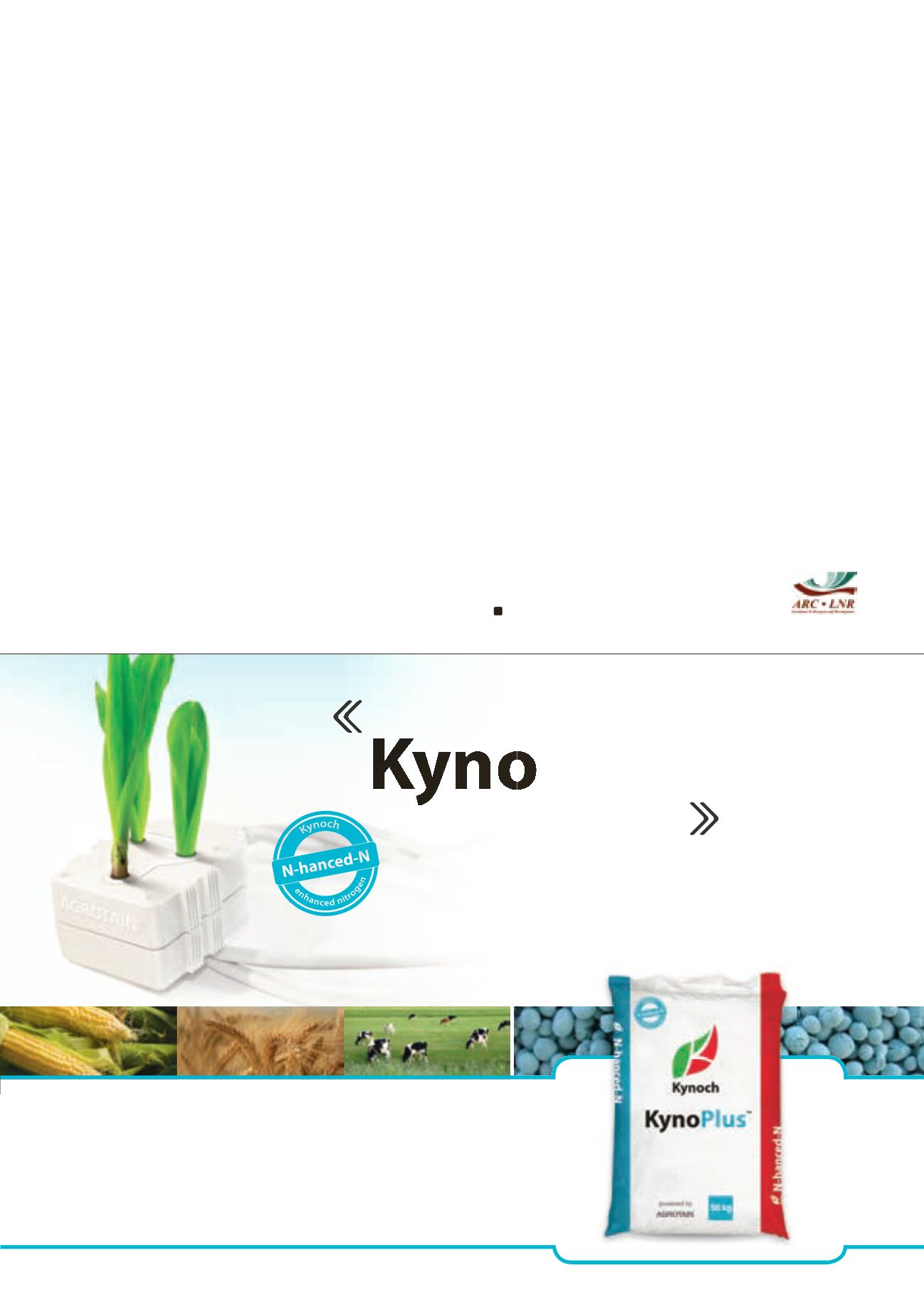

Dryf jou gewasse aan met
N-hanced-N
™
,
‘n nuwe kategorie ∑nhanced stikstofprodukte
vir verbeterde kwaliteit, opbrengs en wins.
011 317 2000 |
www.kynoch.co.zaPlus
™
Ons stel bekend
die
stikstof
kragbron.
Farmisco (Edms) Bpk h.a. Kynoch Kunsmis Reg nr: 2009/0092541/07
KynoPlus
TM
is geregistreer as kunsmis groep 1 - K8024 (Wet 36 van 1947)
KynoPlus
™, die eerste produk in ‘n nuwe reeks
N-hanced-N
™
stikstofdoeltreffende kunsmismengsels.
KynoPlus
™:
• Word aangedryf deur
AGROTAIN
®, ’n vervlugtigingsinhibeerder wat
stikstofdoeltreffendheid verbeter en dus die beskikbare stikstof in die grond verhoog.
• Bied buigsaamheid in toediening.
• Verlaag saailingverlies en verbeter aanvanklike gewasgroei.
Die krag van
blou
sit die
groen
terug in jou gewasse.
Nie handeldrywend inWes-Kaap.
uppe marketing A12821
The trichothecene, NIV, produced by some isolates of Fusarium, is
believed to be more toxic than DON and hence should be of more
importance with respect to food safety. However, there is very little
or no monitoring of NIV concentration levels present in grain.
Many studies have shown that mycotoxins can cause health prob-
lems such as mycoses when fed to farm animals such as pigs. Feed
refusal, vomiting and hyperestrogenism are some of the symptoms
exhibited by pigs.
Mycotoxins may also influence the reproductive performance in
some livestock. Grain containing one or some of these mycotoxins,
may be downgraded or rejected by the food and brewing industries,
because of the health risks associated with mycotoxins.
Although barley is used as a staple food in some regions, it is also
used for the production of malt and beer. When Fusarium-infected
grain is used to produce beer, problems such as gushing of beer
(uncontrolled foaming) are experienced. Mycotoxicosis symptoms
in humans include nausea, diarrhoea, abdominal pain, dizziness, fe-
ver and in severe cases it may lead to throat- and mouth cancer if
consumed regularly.
The analytical methods used for the detection of mycotoxins in in-
fected grain include Enzyme-Linked Immunosorbent Assays (ELISA)
and High Performance Liquid Chromatography (HPLC) tests. The
HPLC method is currently much more sensitive and accurate in
the determination of minute mycotoxin concentrations than the
ELISA test, although it is much more expensive.
According to the European Union the limit of DON contamination
in unprocessed cereals is set on 1,25 parts per million (ppm), where-
as the limit for cereals intended for direct human consumption is
set at 0,75 ppm. In South Africa there are currently no regulations
regarding the measurement or limitation on the amount of DON
present in cereals.
There are five types of resistance described in wheat. Type III re-
sistance is described as resistance to the accumulation of DON in
the infected grain that are currently being used in breeding and pre-
breeding programmes worldwide.
In South Africa, the ARC-Small Grain Institute (ARC-SGI), registered
a Fusarium pre-breeding programme at the Winter Cereal Trust
to combine imported Fusarium- and DON-resistant sources in the
South African irrigation wheat cultivar spectrum.
The development of new sources of resistance will also provide
breeders with greater choice of germplasm and may produce cul-
tivars with Fusarium head blight- and DON-resistance in the future.
In future if similar pre-breeding Fusarium head blight-resistance
research is needed to service the barley, malting and brewing
industries, the pre-breeding team at ARC-SGI will be in the best posi-
tion to assist.
For more information, contact Cathy de Villiers or
Dr Scott Sydenham at the ARC-SGI at 058 307 3400,
DeVilliersC@arc.agric.zaor
SydenhamS@arc.agric.za
.

















